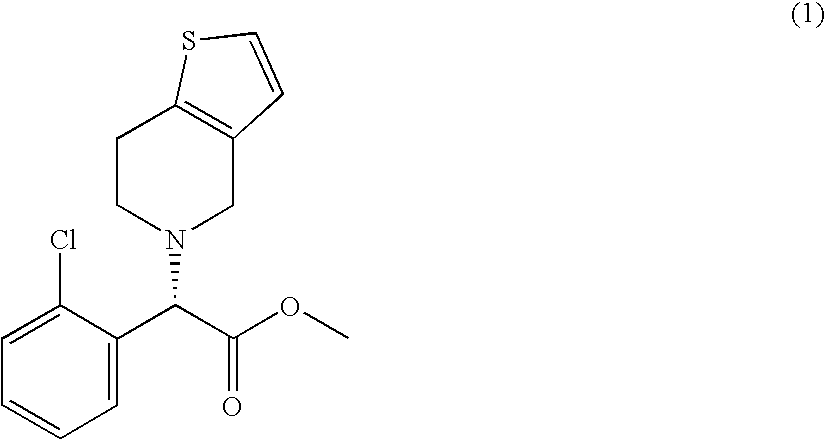Process for the preparation of clopidogrel
a technology of clopidogrel and clopidogrel is applied in the field of process for the preparation of clopidogrel, which can solve the problems of low-melting solids that are hardly available in pure form, and use tetrahydro thienopyridin
- Summary
- Abstract
- Description
- Claims
- Application Information
AI Technical Summary
Benefits of technology
Problems solved by technology
Method used
Image
Examples
example 1
Preparation of N,N″-bis-4,5,6,7-tetrahydro[3,2-c]thienopyridyl methane (12)
Method 1
[0031] 2440 g of anhydrous formic acid (53.04 moles) are placed in a 3 l round-bottom flask, equipped with mechanical stirrer, thermometer and dropping funnel. 500 g of 2-(2-thienyl)ethylamine (4) (3.94 moles) are then slowly added thereto, while allowing temperature to reach 40° C. The resulting solution is cooled at room temperature, then 186.5 g of 95% paraformaldehyde (5.91 moles) are added in 10 minutes. After 14 hours at room temperature, the resulting solution is slowly poured into 6660 g of a 30% w / w sodium hydroxide solution (50 moles), while keeping temperature below 30° C. The resulting suspension is kept under stirring at room temperature for 2 hours, then the precipitated solid is recovered by filtration, washed with water and taken up into 550 ml of methanol. The obtained suspension is stirred at room temperature for 2 hours, then the solid is filtered, washed with methanol and dried ...
example 2
Preparation of methyl (S)-2-(2-chlorophenyl)-2-(4,5,6,7-tetrahydrothieno[3,2-c]5-pyridyl)acetate (1)
Method 1
[0035] 31.6 g (0.108 moles) of N,N″-bis-4,5,6,7-tetrahydro[3,2-c]-thienopyridyl methane (12) and 150 ml of acetonitrile are placed in a 500 ml three-necked round-bottom flask equipped with magnetic stirrer, condenser and dropping funnel. The resulting suspension is kept under nitrogen atmosphere and then refluxed. A solution consisting of 40 g (0.104 moles) of methyl (R)-2-(2-chlorophenyl)-2-(4-nitrobenzenesulfonyloxy)acetate (13a) dissolved in 150 ml of acetonitrile is then added in 1 hour 30 minutes. 1 Hr after the end of the addition, the mixture is cooled to −15° C. and the precipitated solid is filtered. The resulting clear solution is analyzed by HPLC (HPLC yield: 74%). The solvent is evaporated off under reduced pressure and the residue is taken up in toluene (about 600 ml) and treated with a 5% w / w sodium bicarbonate aqueous solution (100 ml). The organic phase is w...
PUM
| Property | Measurement | Unit |
|---|---|---|
| temperature | aaaaa | aaaaa |
| temperature | aaaaa | aaaaa |
| temperature | aaaaa | aaaaa |
Abstract
Description
Claims
Application Information
 Login to View More
Login to View More - R&D
- Intellectual Property
- Life Sciences
- Materials
- Tech Scout
- Unparalleled Data Quality
- Higher Quality Content
- 60% Fewer Hallucinations
Browse by: Latest US Patents, China's latest patents, Technical Efficacy Thesaurus, Application Domain, Technology Topic, Popular Technical Reports.
© 2025 PatSnap. All rights reserved.Legal|Privacy policy|Modern Slavery Act Transparency Statement|Sitemap|About US| Contact US: help@patsnap.com



